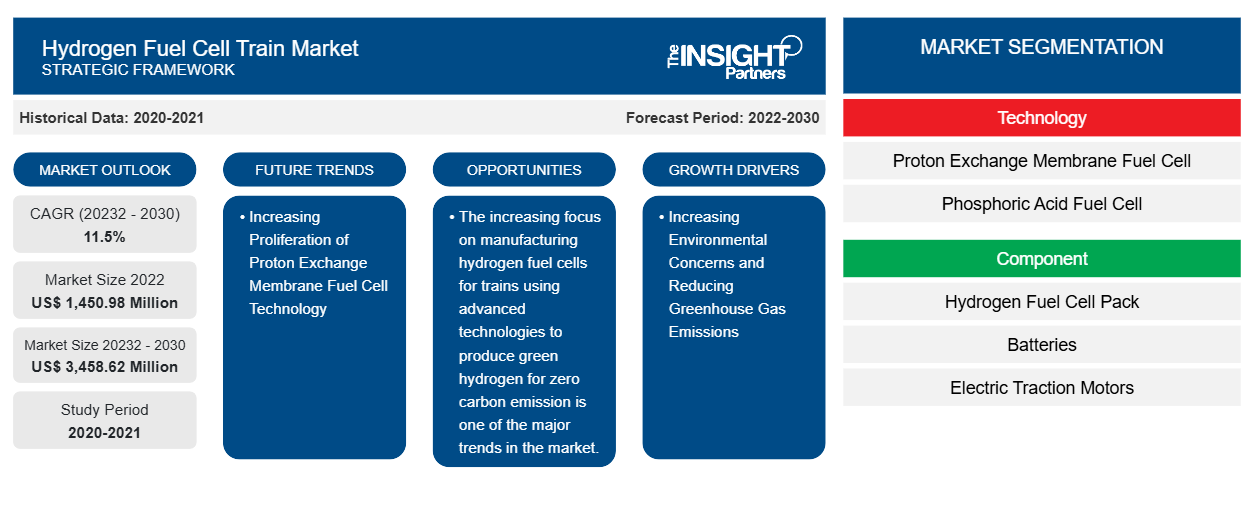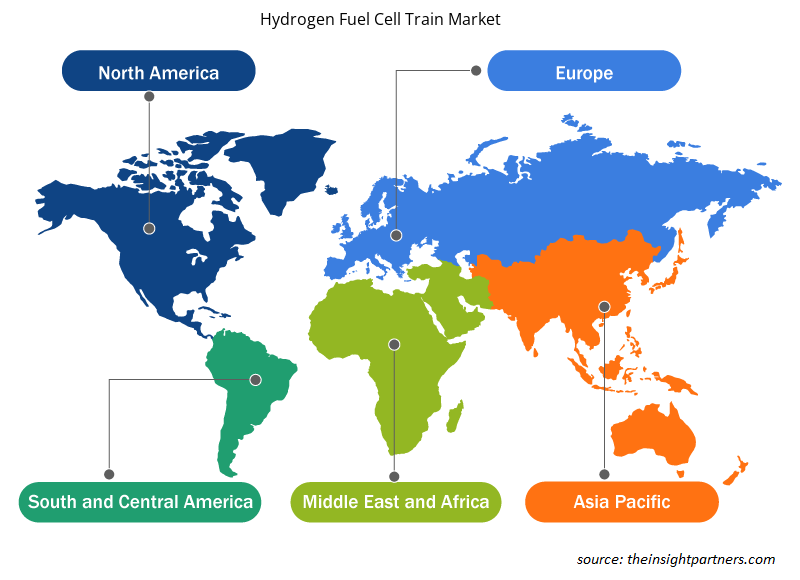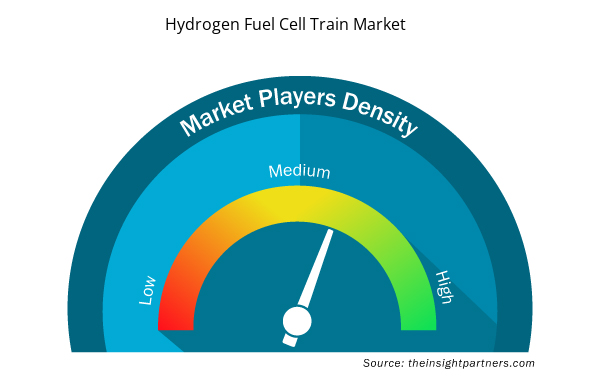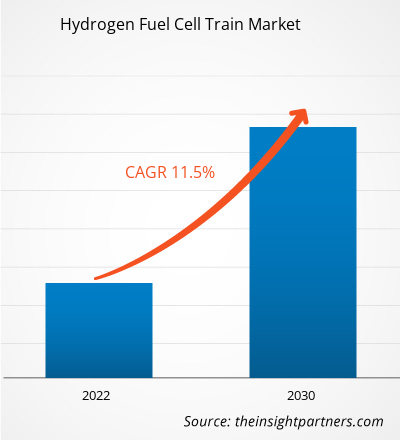The hydrogen fuel cell train market was valued at US$ 1,450.98 million in 2022 and is projected to reach US$ 3,458.62 million by 2030; it is expected to register a CAGR of 11.5% during 2022–2030. The increasing focus on manufacturing hydrogen fuel cells for trains using advanced technologies to produce green hydrogen for zero carbon emission is one of the major trends in the market.
Hydrogen Fuel Cell Train Market Analysis
Growing penetration of the hydrogen cell train across North American countries, including the US, Canada, and Mexico, drives the market growth. In Canada, the expansion of railway tracks in Greater Toronto is anticipated to be completed by 2025. Increasing demand for advanced technologies-based membranes for fuel cell trains is expected to create ample opportunity for market growth. Fuel cells primarily work on the principle of electrochemical reaction by converting chemical energy into electrical power. One of the most promising technologies of fuel cells is the Proton Exchange Membrane (PEM). The PEM fuel cell technology is most suitable for automotive applications owing to its high power density.
Hydrogen Fuel Cell Train Market Overview
Governments of different countries are working toward mitigating carbon emissions in the railway sector, boosting the demand for hydrogen fuel cell trains worldwide. The growing focus on sustainable and environment-friendly alternatives to mitigate environmental pollution is boosting the demand for hydrogen-driven trains as an eco-friendly option in the transportation sector. Companies such as Talgo, Alstom, Ballard Power Systems, and CRRC Corporation are key companies working on developing hydrogen fuel cell trains worldwide. Growing government initiatives such as funding projects and infrastructure development drive the hydrogen fuel cell trains market.
Customize This Report To Suit Your Requirement
You will get customization on any report - free of charge - including parts of this report, or country-level analysis, Excel Data pack, as well as avail great offers and discounts for start-ups & universities
Hydrogen Fuel Cell Train Market: Strategic Insights

- Get Top Key Market Trends of this report.This FREE sample will include data analysis, ranging from market trends to estimates and forecasts.
Customize This Report To Suit Your Requirement
You will get customization on any report - free of charge - including parts of this report, or country-level analysis, Excel Data pack, as well as avail great offers and discounts for start-ups & universities
Hydrogen Fuel Cell Train Market: Strategic Insights

- Get Top Key Market Trends of this report.This FREE sample will include data analysis, ranging from market trends to estimates and forecasts.
Hydrogen Fuel Cell Train Market Drivers and Opportunities
Increasing Environmental Concerns and Reducing Greenhouse Gas Emissions
Changing world scenarios due to pollution control and mitigating greenhouse gas emissions for a polluted environment positively influence the hydrogen fuel cell train market. The primary component of a hydrogen fuel cell train is hydrogen. Hydrogen fuel cell utilizes the chemical energy of hydrogen to generate electricity. The growing government concern toward achieving the net zero carbon emission targets of different countries is fueling the application of eco-friendly alternatives such as hydrogen as the key component for running vehicles and trains instead of conventional diesel engines. For instance, the US government has set a target of reducing carbon emissions by 50-52% by 2030. Canada aimed at lowering 40-45% carbon footprints by 2030. Germany targeted to lower carbon emissions by up to 65% by 2030.
Increasing Proliferation of Proton Exchange Membrane Fuel Cell Technology
Fuel cells train work on the principle of electrochemical reaction that converts chemical energy into electrical power. The technology used for the fuel cell train is the Proton Exchange Membrane (PEM). The PEM technology is suitable for most automotive applications due to its high power and density. The function of PEM fuel cells can be reversed for O2 and H2 generation by using a water electrolysis process. The reverse technology of PEM fuel cells is a promising option for storing excess renewable power. When renewable power generation is more than the required amount, surplus renewable energy can be used to generate H2, and later, it can be converted back to electricity using PEM (Proton Exchange Membrane) fuel cell technology. The key end use of PEM fuel cells emphasizes transportation mainly because of its possible influence on the environment, like reducing the emission of greenhouse gases. Other uses include portable and distributed or stationary power production.
Hydrogen Fuel Cell Train Market Report Segmentation Analysis
Key segments that contributed to the derivation of the hydrogen fuel cell train market analysis are technology, components, rail type, and geography.
- Based on technology, the global market is divided into proton exchange membrane fuel cells, phosphoric acid fuel cells, and others. Several countries have been focusing on integrating various technologies into their respective rail infrastructure as a part of their green initiatives. The railway sector development has been witnessing strong growth due to the introduction of several green energy programs and targets set by governments of different countries, owing to which the hydrogen fuel cell train market witnesses lucrative opportunities for growth. Proton exchange membrane fuel cell (PEMFC) is one of the most commonly used hydrogen fuel cell technologies in the railways industry.
- Depending upon the component, the market is divided into hydrogen fuel cell packs, batteries, electric traction motors, and others. A fuel cell system comprises components such as a cell pack, batteries, traction motors, inverters, storage units, and other components. All the components have different functions that collaboratively work together to run the hydrogen-powered trains. The growth in the number of innovations in railway systems is a major factor supporting the global hydrogen fuel cell pack market growth. Some of the major companies providing hydrogen fuel cell packs are Ballard Power Systems Inc., Intelligent Energy Ltd, FuelCell Energy Inc., Doosan Fuel Cell Co Ltd, Plug Power Inc, and Bloom Energy.
Based on rail type, the market is divided into passenger rail, commuter rail, light rail, trams, freight, and others. The demand for passenger trains is growing rapidly across different regions. This is mainly due to the rise in passenger traffic across different countries worldwide.
Hydrogen Fuel Cell Train Market Share Analysis by Geography
The geographic scope of the hydrogen fuel cell train market report is mainly divided into five regions: North America, Asia Pacific, Europe, Middle East & Africa, and South & Central America.
North America is expected to have the largest share in 2022 across the global hydrogen fuel cell train market. This is owing to increasing US government investment in the development of fuel cell technologies for the trains. In 2023, the Canadian government began hydrogen trains in Canada. Also, the region comprises several key players in the market, such as Alstom and Ballard Power Systems. These companies have become one of the pioneers in the hydrogen fuel cell technologies for hydrogen fuel cell trains across the world. Many countries have already provided contracts for hydrogen fuel cell train technologies to these companies to advance their rail infrastructure and take a strong step toward a zero-emission future. In 2022, Stadler Rail-one of the rolling stock manufacturers signed a contract with Ballard Power Systems to provide its hydrogen fuel cell products for the first hydrogen train in the US.
Hydrogen Fuel Cell Train Market Regional Insights
The regional trends and factors influencing the Hydrogen Fuel Cell Train Market throughout the forecast period have been thoroughly explained by the analysts at Insight Partners. This section also discusses Hydrogen Fuel Cell Train Market segments and geography across North America, Europe, Asia Pacific, Middle East and Africa, and South and Central America.

- Get the Regional Specific Data for Hydrogen Fuel Cell Train Market
Hydrogen Fuel Cell Train Market Report Scope
| Report Attribute | Details |
|---|---|
| Market size in 2022 | US$ 1,450.98 Million |
| Market Size by 2030 | US$ 3,458.62 Million |
| Global CAGR (20232 - 2030) | 11.5% |
| Historical Data | 2020-2021 |
| Forecast period | 2022-2030 |
| Segments Covered |
By Technology
|
| Regions and Countries Covered | North America
|
| Market leaders and key company profiles |
Hydrogen Fuel Cell Train Market Players Density: Understanding Its Impact on Business Dynamics
The Hydrogen Fuel Cell Train Market market is growing rapidly, driven by increasing end-user demand due to factors such as evolving consumer preferences, technological advancements, and greater awareness of the product's benefits. As demand rises, businesses are expanding their offerings, innovating to meet consumer needs, and capitalizing on emerging trends, which further fuels market growth.
Market players density refers to the distribution of firms or companies operating within a particular market or industry. It indicates how many competitors (market players) are present in a given market space relative to its size or total market value.
Major Companies operating in the Hydrogen Fuel Cell Train Market are:
- Alstom SA
- TWI Ltd
- Hyundai Corporation
- Talgo
- Siemens Mobility GmbH
- CRRC Corp Ltd
Disclaimer: The companies listed above are not ranked in any particular order.

- Get the Hydrogen Fuel Cell Train Market top key players overview
Hydrogen Fuel Cell Train Market News and Recent Developments
The hydrogen fuel cell train market is evaluated by gathering qualitative and quantitative data post primary and secondary research, which includes important corporate publications, association data, and databases. A few of the developments in the Hydrogen Fuel Cell Train Market are listed below:
- The Indian Railways has designed a train which will run on Hydrogen Fuel Cell, Railway Minister Ashwini Vaishnaw informed the Lok Sabha in a written reply. The Integral Coach Factory, Chennai, has planned its production. (Source: The Economic Times Press Release, February 2024)
- LNVG, which the government of Lower Saxony owns, had invested more than US$ 85 million in 14 hydrogen fuel-cell trains, which began operating in August 2022. The federal government also contributed US$ 9.06 million to the world’s first H2 train refueling station, built by Linde in the town of Bremervörde. (Source: Hydrogen Insights Press Release, August 2022)
Hydrogen Fuel Cell Train Market Report Coverage and Deliverables
The “Hydrogen Fuel Cell Train Market Size and Forecast (2020–2030)” report provides a detailed analysis of the market covering below areas:
- Hydrogen fuel cell train market size and forecast at global, regional, and country levels for all the key market segments covered under the scope
- Hydrogen fuel cell train market trends as well as market dynamics such as drivers, restraints, and key opportunities
- Detailed PEST and SWOT analysis
- Hydrogen fuel cell train market analysis covering key market trends, global and regional framework, major players, regulations, and recent market developments
- Industry landscape and competition analysis covering market concentration, heat map analysis, prominent players, and recent developments for the hydrogen fuel cell train market
- Detailed company profiles
- Historical Analysis (2 Years), Base Year, Forecast (7 Years) with CAGR
- PEST and SWOT Analysis
- Market Size Value / Volume - Global, Regional, Country
- Industry and Competitive Landscape
- Excel Dataset



Report Coverage
Revenue forecast, Company Analysis, Industry landscape, Growth factors, and Trends

Segment Covered
Technology, Component, Rail Type, and Geography

Regional Scope
North America, Europe, Asia Pacific, Middle East & Africa, South & Central America

Country Scope
This text is related
to country scope.
Frequently Asked Questions
The market is expected to register a CAGR of 11.9% during 2023–2031.
The hydrogen fuel cell train market size is projected to reach US$ 3,821.4 million by 2031 from US$ 1,554.32 million in 2023.
Alstom SA, TWI Ltd, Hyundai Corporation, Talgo, Siemens Mobility GmbH, CRRC Corp Ltd, WABTEC, Stadler Rail AG, and Ballard Power Systems are among the major companies operating in the hydrogen fuel cell train market.
The increasing focus on manufacturing hydrogen fuel cells for trains using advanced technologies to produce green hydrogen for zero carbon emission is one of the major trends in the market.
Increasing Environmental Concerns and Reducing Greenhouse Gas Emissions
North America is expected to dominate the hydrogen fuel cell train market in 2023.

 Get Free Sample For
Get Free Sample For